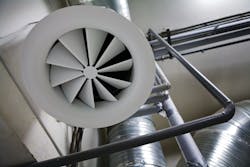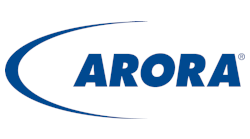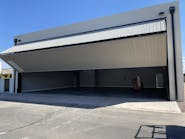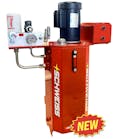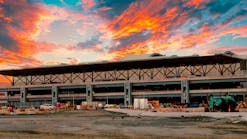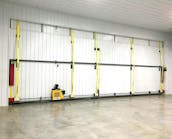The COVID-19 pandemic has changed the way everything is thought about in an airport, even all the way up into the vents. The respiratory nature of the virus has brought heating, ventilation and air conditioning (HVAC) systems into the spotlight – what role do they play in spreading the virus and how can they be modified to stop it?
Ryan Meyer, Director of Planning and Programming for the Lehigh-Northampton Airport Authority (LNAA), said that since the pandemic struck, he’s had to think about HVAC systems more than he ever thought he would.
Last March, right as the US was coming under COVID-19’s grip, Meyer said the LNAA was in the middle of designing a new security checkpoint for Lehigh Valley International Airport (ABE).
“We were fortunate to still be working through design when the pandemic struck, so we worked hard to incorporate enhancements in the design. Basically, it boiled down to: How do we incorporate more than just movement of air, introduction of outdoor air, and airflow capacity; how do we take it one step further?” he said.
If the project had been started just a few months early, before the virus was on the world’s radar, Meyer said the HVAC conversation would have mostly focused on standard goals of energy efficiency and comfort.
“Over five years ago we upgraded one of our main terminal chillers, which is a critical component to providing conditioned air throughout the terminal. That upgrade was due to the need to replace legacy equipment that was beyond its useful life. So, when we did those improvements, it was more about energy efficiency, passenger comfort, and maintaining adequate temperatures,” Meyer recounted.
Now, Meyer and his team weigh options such as the installation of UV lights or other proprietary systems in conjunction with the HVAC system to neutralize any airborne pathogens, such as the COVID-19 virus.
“We've definitely thought about what additional objectives should be incorporated into the new construction. And then, in terms of the existing facilities, the question really is how can we add specific elements to further clean the air over the standard HEPA filtration while meeting our other design objectives and still ensuring it can fit the space limitations within the facility?” Meyer said.
“The COVID-19 pandemic has required us to evaluate what we can add to our existing HVAC systems within the existing space. Would the improvements be within the mechanical rooms or incorporated above the ceiling? Is it replacing some of the duct work? The different components that I think could be done simply requires evaluation. And then, ultimately, the cost impacts of how we could potentially incorporate the improvements in subsequent phases.” Meyer continued.
Unique Systems and Unique Challenges
When thinking about how an airport’s HVAC system can be modified for the pandemic-era, it’s important to first recognize that these systems are unlike those found in other buildings.
“Airports themselves are unique in that they are never truly unoccupied and experience tremendous fluctuations in occupancy as passengers board and disembark from their flights. In terms of structure, terminals often have tall ceilings with substantial unoccupied vertical space. These distinct circumstances create an environment that requires nimbler HVAC systems, notably Variable Air Volume (VAV) systems, to react to these large fluxes of people by modulating the amount of outside air and total supply air to the occupied spaces,” said David Marsh, practice lead of mechanical engineering, Arora Engineers, Inc.
Another factor airport systems have to contend with is bringing in outside air without the pollution of the ramp, as Bradley Perrott, facilities practice lead, Hanson Professional Services Inc., described.
“You're taking the less-than-ideal outdoor air quality that you get with a taxiway and runway from jet fumes and then you're combining that with the busyness of an indoor terminal with lots of transient people, which of course, lots of people requires lots of outside air. So, you have to be able to introduce that outside air, mitigating with the fumes issue you get from the taxiways and runways,” Perrott said.
Combined then with the numerous large, open spaces of airports and the multitude of different facilities in an airport, such as retail and restaurants with each requiring differing ventilation and heating and cooling loads, airport HVAC systems become some of the most complex of their kind.
It’s all about maintaining the right balance said Wade Conlan, commissioning and energy discipline manager, Hanson Professional Services Inc. and voting member of the ASHRAE Epidemic Task Force, with now the virus further complicating the balancing act.
“It's just something to try and figure out that balancing point of bringing in the right amount of outdoor air, but not wasting the energy to do so,” Conlan said. “In the age of COVID, it even changes further because while airports are traditionally designed to keep the passengers and the people comfortable, out of the elements and not having the jet fuel smells;, when you add COVID into the mix, you're now trying to operate that for safety like you would a hospital patient room or a laboratory building.”
Making Changes
“Airports as well as other buildings are looking to make an immediate impact regarding HVAC renovations,” Jeff Farley, senior mechanical engineer at TDIndustries, Inc., added. “Filter changeouts may be happening more frequently and ultra-violet germicidal irradiation (UVGI) technologies are being installed in air handling equipment.”
Marsh said the Arora team has explored and produced a whitepaper on a number of the new technologies to fight COVID-19, including bipolar ionization, hydrogen peroxide disinfection technology and ultraviolet (UV-C) light purification systems.
“Many of these pathogen-mitigating systems can be applied to new or existing HVAC systems in order to improve indoor air quality and promote health and safety for passengers and airport staff,” he said.
An easy step for airports to take with their HVAC systems is to increase the airflow rates along with beefing up filtration.
“Having the right amount of outdoor air that your system can handle and not using too much energy will help dilute the space from potential particles,” Conlan said. “For the filters themselves, most buildings you see are currently using MERV 8 filters. ASHRAE recommends a MERV-13 if the systems will allow.”
“A MERV 13 filter at a one micron particle size is twice as efficient at capturing than a MERV-8 filter, but there's studies out there that show that if you have a half-inch gap in that filter system, that it could halve the performance of your filter system. So, you could have a really well-installed MERV 11 that is better than a poorly-installed MERV 13,” he continued.
Farley warned, though, that there is no quick or one-size-fits-all solution to the challenges COVID possesses, and changes need to take into account the balancing act these systems must maintain.
“If it sounds easy then it may not be the right approach. Any change must be carefully evaluated by industry professionals to determine if the proposed change results in a reduction of overall system performance. Increasing the filter MERV rating may very well create reduced airflow due to the increased static pressure of the filters,” Farley said.
“I think as we move forward, it's to try and help provide the guidance on that balancing act of safety versus energy consumption, because some of the mitigation strategies appear to increase the energy use,” Conlan added.
The first step to any change, though, is an evaluation of the current HVAC system.
“When considering a change to their HVAC systems, we recommend that airports, after performing a comprehensive analysis of their existing systems, determine what modifications they can make to increase filtration, ventilation and potentially introduce pathogen-mitigating technologies. This assessment, along with an airport’s consideration of pathogen-mitigating technologies such as electrostatic air filters, bipolar ionization, hydrogen peroxide disinfection technology etc., can help the airport decide which HVAC systems it would make more sense to replace rather than retrofit,” Marsh said.
“You really want to be able to document what you're doing,” agreed Conlan. “Part of that analysis that I talk about in terms of evaluating your filters and your outside air is documenting what your systems are actually doing today, right? Then you have that evaluation of, ‘What can we do? What can we tweak? What can we add?’ That's one of those things for a BAS, you want to try and make sure that you do them, in essence, one at a time. You're slowly tweaking the system to make sure that you're not causing different issues or things that you may not have thought about.”
“When changes are made to the system, it is critical to implement them when the operation can be evaluated over time,” Farley said. “Adding humidification during the summer months allows the work to be performed and the sequence of operation to be verified prior to the drier winter months when humidification is needed.”
The Airport’s Air
Meyer said the Lehigh-Northampton Airport Authority (LNAA) is considering two potential options: installing UV lights or other components into their existing HVAC systems and equipping the new security checkpoint with proprietary equipment with the ability to remove pathogens from the air.
“Unless you are doing a major upgrade or renovation, there's very little you can do about the existing air circulation within the facility other than simply replacing air filters. You can keep the system fans running longer than they had before with potential for greater outside air inclusion if the system can support it. But in general, unless you make a substantial investment, it's pretty challenging to make significant upgrades,” Meyer said of making changes to their existing infrastructure.
As they weigh their options, Meyer said the LNAA is keeping the future and their passengers in mind. Meyer said he sees a post-pandemic future with passengers remaining health conscious and aware of what illnesses they may encounter while travelling, so any project needs to do more than in the past to ensure people feel safe and confident to fly through our facility.
“If you look back in history, it seems there has always been some type of respiratory virus, contained to specific geographical areas. COVID-19 has obviously had a global impact, but it just makes you wonder what other variant do we not know of that could be coming in the future?” Meyer said. “And that's one of the main elements we've talked about a lot with the designers with our checkpoint, is trying to plan for the unknown and provide a safe and healthy facility for our passengers.
“We're all learning and adapting to this COVID-19 pandemic. But if something like this happens again, or some version of it, we want to make sure that we have done everything we can to be prepared for it, to keep our passengers and traveling public safe as they come to the facility, even as it relates to the seasonal flu and other pathogens.” he continued.
